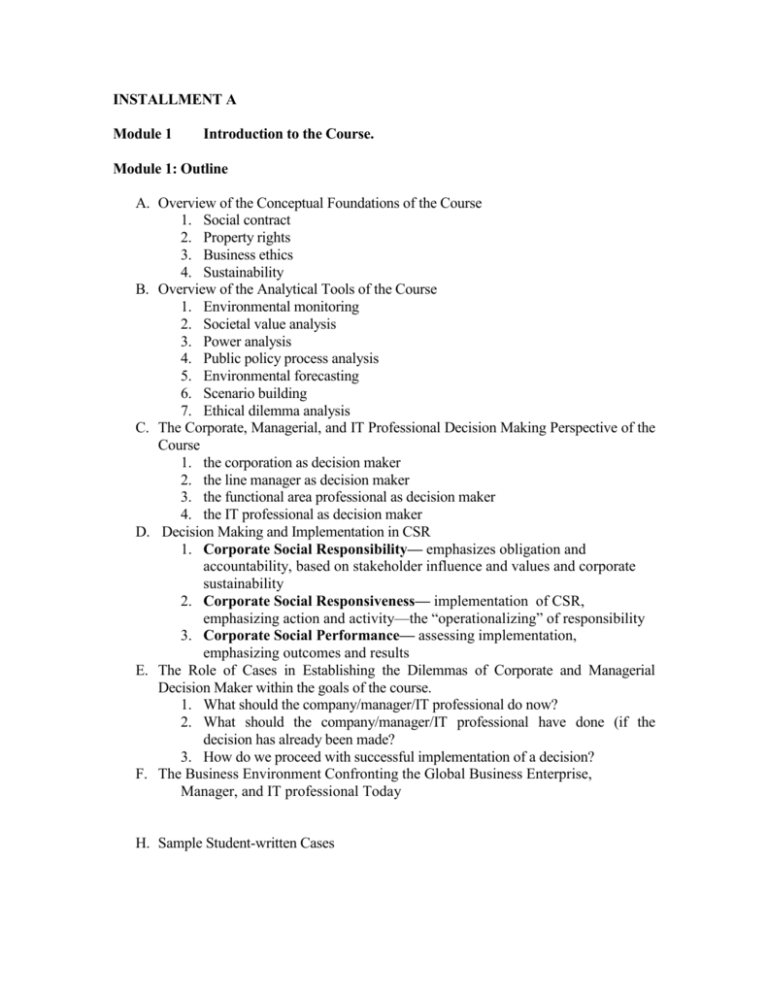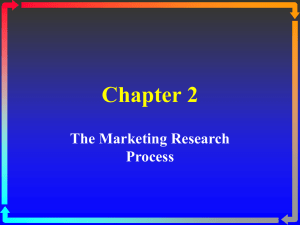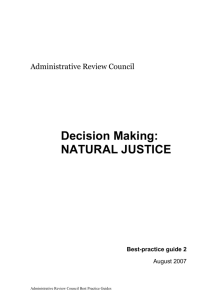Module 1
advertisement

INSTALLMENT A Module 1 Introduction to the Course. Module 1: Outline A. Overview of the Conceptual Foundations of the Course 1. Social contract 2. Property rights 3. Business ethics 4. Sustainability B. Overview of the Analytical Tools of the Course 1. Environmental monitoring 2. Societal value analysis 3. Power analysis 4. Public policy process analysis 5. Environmental forecasting 6. Scenario building 7. Ethical dilemma analysis C. The Corporate, Managerial, and IT Professional Decision Making Perspective of the Course 1. the corporation as decision maker 2. the line manager as decision maker 3. the functional area professional as decision maker 4. the IT professional as decision maker D. Decision Making and Implementation in CSR 1. Corporate Social Responsibility— emphasizes obligation and accountability, based on stakeholder influence and values and corporate sustainability 2. Corporate Social Responsiveness— implementation of CSR, emphasizing action and activity—the “operationalizing” of responsibility 3. Corporate Social Performance— assessing implementation, emphasizing outcomes and results E. The Role of Cases in Establishing the Dilemmas of Corporate and Managerial Decision Maker within the goals of the course. 1. What should the company/manager/IT professional do now? 2. What should the company/manager/IT professional have done (if the decision has already been made? 3. How do we proceed with successful implementation of a decision? F. The Business Environment Confronting the Global Business Enterprise, Manager, and IT professional Today H. Sample Student-written Cases As the syllabus describes, you will be required to develop a case for the course in a form that can be presented to other students for analysis, and then analyzed yourself. Three examples of student-written cases and analyses are presented for your consideration. Synopsis of the course: How can I, as a business manager and IT professional, best meet the expectations of the continuously changing and often ambiguous social contract and roster of contending stakeholders while still meeting my fiduciary and professional responsibilities and building a “sustainable” enterprise in the short- and long-run? A Pictorial Representation of Corporate Social Responsibility A PYRAMID OF BUSINESS RESPONSIBILITIES desired Philanthropy . Ethical Responsibilities Required by economic contracts and law . Social Responsibilities Economic and Legal Responsibilities expected of professional employees Subject to societal values and power of stakeholders Module 1. Text This Corporate Social Responsibility course has four basic, interrelated conceptual foundations: social contract, property rights, business ethics and sustainability. These concepts are overlaid on the basic principles of business operations—the need to assemble the necessary factors of production to produce a product that will enable the firm to be competitive in the marketplace. Following an overview of the historical development of “corporate social responsibility” in the US and other developed economies in Module 2, the course will go into detail on these conceptual foundations, beginning with social contract and property in Module 3. As the Syllabus states, this course is taught from the perspective of the enterprise, with the enterprise, business manager or IT professional as the focal decision maker. The student who successfully completes this course will have the majority of the analytical tools necessary to confront the full range of issues that fall within the broad framework of “corporate social responsibility” or “CSR” and sustainability. Those analytical tools are introduced in Modules 5 through 10, and include: environmental monitoring, societal value analysis, power analysis, environmental forecasting, Environmental forecasting, public policy process analysis, and analysis of ethical dilemmas. Each module contains a case that will require your analysis and decision making, using the analytical tools that have been introduced in the course up to that point in time. In the cases analyses, the student assume the role of the corporate and/or managerial decision make. That decision maker may be at the top of the business organization wherein the CEO decision is synonymous with the decision of the corporation, or a a lower level, either the line manager or functional area professional. In making decisions, one can think of three levels: the decision, the implementation or “operationalize” of the d, and the assessment of the results—were the intended objectives realized. These three levels of decision making correspond to three terms you should become familiar with: a. Corporate Social Responsibility— emphasizes obligation and accountability, based on stakeholder influence and values and corporate sustainability b. Corporate Social Responsiveness— implementation of CSR, emphasizing action and activity—the “operationalizing” of responsibility c. Corporate Social Performance— assessing implementation, emphasizing outcomes and results d. The cases we use in this course are of two types: (a) where some key events have occurred and a decision has to be made, and (b) where a decision has already been made, implemented, and there has been at least a preliminary result. In the first, we pose the question: What should the company/manager do now, including, “How do we proceed with successful implementation of a decision?” In the second, we pose the question: With the benefit of hindsight, what should the company/manager have done? As we emphasize in the outline, the business environment confronting the global Business enterprise, manager and IT professional today is not an easy one. It is: Highly competitive Global—the world is flat” Complexity in supply chain structure Dynamic in its processes—new entrants Uncertainties of modern technology Activism of new “stakeholders, especially non-governmental organizations (NGOs) and other groups Increased government role in business decisions Overall level of affluence in Western society Extended time horizon for policy and strategy Success is dependent on ability to understand national macroeconomic, social and political systems -need to detect significant environmental changes early in order to -develop appropriate organizational strategies and responses before the full potential impact on the firm. It is within this challenging context that we pose the key question of this course: How can I, as a business manager, best meet the expectations of the continuously changing and often ambiguous social contract and roster of contending stakeholders while still meeting my fiduciary and professional responsibilities and building a “sustainable” enterprise in the short- and long-run?











